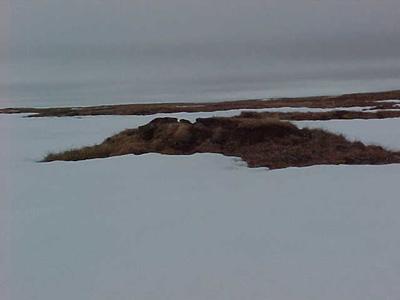9 June, 2001
Saturday
As anywhere else the weekends are not as hectic work wise as weekdays. This
weekend promises to be slower than most. We are still getting instruments
ready and projects organized. Glen tells us this will not be true for all
weekends however! We stayed in the lab catching up on reading and writing.
After lunch, Spring and I went out to the site to return 4 cells to the soil
moisture measuring instrament. Out in the field most all instruments are
kept inside 10 or 20-gallon igloo coolers. The instruments put out heat when
operating, the chests keep the heat in and this prevents the electronics from
freezing. Most instruments are run on simple batteries, from flashlight to
12 volt. In our case we are close enough to electric cables that we have a
direct electrical connection
Soil moisture measurements are important when determining CO2 flux. Picture
soil, which is composed of separate grains of material, which fit tightly
together, like marbles in a cup. Between each grain is a space, tiny but
it's there. When soil moisture is high these spaces are filled with water.
With water in the spaces gas exchanges cannot take place. Now, dry out that
soil and you leave the spaces open and gases, like CO2, can fill those spaces.
When plants grow the roots take up O2 and give off CO2 during respiration.
Bacterias in the soil, whose main function is to decompose materials, also
produces CO2. Thus, with these two CO2 sources, the gases build up in the soil
and can potentially be released into the atmosphere. What's going on in the
pore spaces is an important variable to consider when measuring CO2 flux.
Right now, because of the spring melt, soil moisture is high but as the summer
season progresses there will be measurable changes.
Walking back to the truck I took a picture of an area of uplifted tundra.
This is a landscape form found in the arctic referred to as a "tundra boil".
They are caused by the constant freezing and thawing of the layers under the
surface. When the water, in the active layer freezes it expands, pushing the
surface upward. Cracks develop in the ground surface. Thawing allows more
water to seep into these surface cracks and then the area freezes once again
pushing the surface layer up higher. Eventually the lower layers are brought
to the surface and the soils are turned (cryo-turbation). From a distance the
tundra has a flat look to it but on walking on it you see how hummocky (hilly)
it really is. The surface rolls very gently for hundreds of miles till it
reaches the foothills of the Brooks Range, which is about 150 miles south.
In the arctic the permafrost layer is the primary sculptor or the landscape
with alternating cycles of freezing and thawing its tool.
On the way back to the lab we stopped of to take some pictures of the
whalebones that are on display all around the area. The native people, the
Inupiat, hunt the bowhead whale and it is not uncommon to see head and rib
bones decorating the landscape. Standing next to these you get the idea of
how big these marine mammals are and the skill and energy it must take to
capture and kill them.

This is the shoreline boarding the skeletons. The ice is still safe to walk on but with the temperatures rising every day that will not be true for long.

Coming back from the site we pulled off the road to take a closer look at the bow head whale skeletons. The frozen ocean is in the background.

This is the data logger which stays at the site and collects soil moisture measurements. Soil moisture is important to know when figuring CO2 flux.

Spring is replacing the storage cells here. We walked back to the site today to replace the 4 cells seen in the bottom, left of the ice chest. These cells hold the data till we bring the cells back to the lab and download the soil moisture data into the computer.

This raised area of tundra is a small "pingo". It's an arctic landform which is formed buy the freezing and thawing of the water that lies beneath the tundra surface. The landscape is dotted with these in this area bur further inland one can find much larger ones.
Contact the TEA in the field at
.
If you cannot connect through your browser, copy the
TEA's e-mail address in the "To:" line of
your favorite e-mail package.
|
